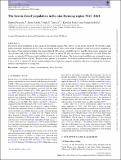Files in this item
The brown dwarf population in the star-forming region NGC 2264
Item metadata
| dc.contributor.author | Pearson, Samuel | |
| dc.contributor.author | Scholz, Aleks | |
| dc.contributor.author | Teixeira, Paula S. | |
| dc.contributor.author | Mužić, Koraljka | |
| dc.contributor.author | Eislöffel, Jochen | |
| dc.date.accessioned | 2020-10-27T16:57:01Z | |
| dc.date.available | 2020-10-27T16:57:01Z | |
| dc.date.issued | 2020-12 | |
| dc.identifier | 270886208 | |
| dc.identifier | 7daf95be-3bd2-4261-a2f5-fa5249e5d760 | |
| dc.identifier | 85096897368 | |
| dc.identifier | 000587762900056 | |
| dc.identifier.citation | Pearson , S , Scholz , A , Teixeira , P S , Mužić , K & Eislöffel , J 2020 , ' The brown dwarf population in the star-forming region NGC 2264 ' , Monthly Notices of the Royal Astronomical Society , vol. 499 , no. 2 , pp. 2292–2302 . https://doi.org/10.1093/mnras/staa2997 | en |
| dc.identifier.issn | 0035-8711 | |
| dc.identifier.other | BibCode: 2020MNRAS.tmp.2813P | |
| dc.identifier.other | ORCID: /0000-0002-3665-5784/work/82501065 | |
| dc.identifier.uri | https://hdl.handle.net/10023/20835 | |
| dc.description | Funding: We acknowledge support from STFC through grant number ST/R000824/1. KM acknowledges funding by the Science and Technology Foundation of Portugal (FCT), grant nos IF/00194/2015, PTDC/FIS-AST/28731/2017, and UIDB/00099/2020. | en |
| dc.description.abstract | The brown dwarf population in the canonical star-forming region NGC 2264 is so far poorly explored. We present a deep, multiwavelength, multiepoch survey of the star-forming cluster NGC 2264, aimed to identify young brown dwarf candidates in this region. Using criteria including optical/near-infrared (IR) colours, variability, Spitzer mid-IR colour excess, extinction, and Gaia parallax and proper motion (in order of relevance), we select 902 faint red sources with indicators of youth. Within this sample, we identify 429 brown dwarf candidates based on their IR colours. The brown dwarf candidates are estimated to span a mass range from 0.01 to 0.08 M⊙. We find rotation periods for 44 sources, 15 of which are brown dwarf candidates, ranging from 3.6 h to 6.5 d. A subset of 38 brown dwarf candidates show high-level irregular variability indicative of ongoing disc accretion, similar to the behaviour of young stars. | |
| dc.format.extent | 4542402 | |
| dc.language.iso | eng | |
| dc.relation.ispartof | Monthly Notices of the Royal Astronomical Society | en |
| dc.subject | Brown dwarfs | en |
| dc.subject | Stars: low-mass | en |
| dc.subject | Catalogues | en |
| dc.subject | Surveys | en |
| dc.subject | QB Astronomy | en |
| dc.subject | QC Physics | en |
| dc.subject | DAS | en |
| dc.subject.lcc | QB | en |
| dc.subject.lcc | QC | en |
| dc.title | The brown dwarf population in the star-forming region NGC 2264 | en |
| dc.type | Journal article | en |
| dc.contributor.sponsor | Science & Technology Facilities Council | en |
| dc.contributor.institution | University of St Andrews. School of Physics and Astronomy | en |
| dc.contributor.institution | University of St Andrews. St Andrews Centre for Exoplanet Science | en |
| dc.identifier.doi | 10.1093/mnras/staa2997 | |
| dc.description.status | Peer reviewed | en |
| dc.identifier.url | http://adsabs.harvard.edu/abs/2020MNRAS.tmp.2813P | en |
| dc.identifier.grantnumber | ST/R00824/1 | en |
This item appears in the following Collection(s)
Items in the St Andrews Research Repository are protected by copyright, with all rights reserved, unless otherwise indicated.

